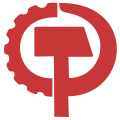John Reed Clubs
- Not to be confused with the band, The John Reed Club, of Ivy League Records
The John Reed Clubs were an American federation of local organizations targeted towards Marxist writers, artists, and intellectuals, named after the American journalist and activist John Reed. Established in the fall of 1929, the John Reed Clubs were a mass organization of the Communist Party USA which sought to expand its influence among radical and liberal intellectuals. The organization was terminated in 1935.
Organizational history
Founding
The John Reed Club was founded in October 1929 by staff members of The New Masses magazine to support leftist and Marxist artists and writers. Originally politically independent, it and The New Masses officially affiliated with the Communist Party in November 1930. The organization published a magazine called Left Front. The organization's New York club was instrumental in launching the literary magazine Partisan Review in 1934.
Chapters
John Reed Club chapters peaked at 30. From New York, it spread to Chicago, Detroit, San Francisco, Boston, and other cities. The Boston chapter was cofounded by writer Eugene Gordon.[1]
Art Exhibitions
Artistic members of the John Reed Club of New York began holding art exhibitions in late 1929, shortly after the club's formation.
The first art exhibition occurred at the United Workers' Cooperative Apartments (aka United Workers Cooperative Colony, aka "Commie Coops") on Bronx Park East in December 1929. Artists included: Jacob Burck, Fred Ellis, William Gropper, Eitaro Ishigaki,[2] Gan Kolski, Louis Lozowick, Jan Matulka, Morris Pass, Anton Refregier, Louis Leon Ribak, Esther Shemitz, Otto Soglow, and Art Young.[3]
The second exhibition occurred in January 1930: 42 drawings, paintings, and lithographs that traveled from the Borough Park Workers' Club (43rd Street, Brooklyn) to other clubs in Brownsville, Williamsburg, the Bronx, and Manhattan.[3]
The third exhibition occurred in April 1931 with the "Proletpen," a Yiddish cultural group of the Communist Party: it comprised some 100 paintings, drawings, and cartoons by some 30 artists.[3]
"Twenty John Reed Club Artists on Proletarian and Revolutionary Themes" occurred at the American Contemporary Art (ACA) Gallery in November 1932: 36 paintings, drawings, and lithographs by 21 artists – Albert Abramowitz, Bard, Mark Baum, Joseph Biel, Jacob Burck, Dehn, Hugo Gellert, William Gropper, [William Hernandez], Eitaro Ishigaki, Limbach, Louis Lozowick, Moses Oley, Quirt, Anton Refregier, Philip Resman, Louis Leon Ribak, William Siegel, Soglow, Raphael Soyer, and Max Spivach. Four known works comprised Gellert's "Karl Max' Capital in Lithographs" (from a set of 60 lithographs).[3]
Another exhibition occurred again at the ACA Gallery[4] in 1935: its theme was the Japanese invasion of Manchuria and included "Roustabouts" by Joe Jones.
The last known exhibition occurred at the ACA Gallery: its theme was "The Capitalist Crisis" and gained little notice outside of Communist press organs.
The site of the John Reed Club in New York held exhibitions of member work from the summer of 1930; it established a gallery there in 1932. Records are scarce for 1932-1935.[3]
Members
The John Reed Club had a somewhat prestigious membership in its early days among leftist circles. Later, it was sometimes used in reference as badge of shame by anti-communists.
The John Reed Clubs were not founded by the Communist Party. New Masses managing editor Walt Carmon became frustrated with a group of young writers who were hanging out in the office and getting in his way.[5] He told them to "go out and form a club" and "call it the John Reed Club."[5] The John Reed Clubs would be a constant source of drama within the New Masses family, and members of the Clubs would eventually found the Partisan Review, which became a main competitor to the New Masses. Samuel Lewis Shane and Whittaker Chambers were members in New York. Richard Wright and the artist Morris Topchevsky were members in Chicago. (In 1944, Wright distilled his uncomfortable experience in an Atlantic Monthly article, "I Tried to be a Communist".)
Dissolution and legacy
The clubs were dissolved into the American Artists' Congress in 1936 by order of the American Communist Party.[6]
Footnotes
- ↑ Elizee, Andre. "Eugene Gordon Papers". New York Public Library website, April 2006.
- ↑ Eitaro Ishigaki, from the Federal Art Project, Photographic Division collection - Image Gallery | Archives of American Art, Smithsonian Institution
- 1 2 3 4 5 Hemingway, Andrew (2002). Artists on the Left: American Artists and the Communist Movement, 1926-1956. Yale University Press. pp. 47–48, 63, 67. ISBN 0-300-09220-2. JSTOR 1504057.
- ↑ "About the ACA Galleries". ACA Galleries. Retrieved 2010-05-27.
- 1 2 Wald, Alan (2002). Exiles from a Future Time: The Forging of the Mid-Twentieth Century Literary Left. Chapel Hill and London: The University of North Carolina Press. p. 105. ISBN 0-8078-5349-6.
- ↑ Marquardt, Virginia Hagelstein (1989). ""New Masses" and John Reed Club Artists, 1926-1936: Evolution of Ideology, Subject Matter, and Style". The Journal of Decorative and Propaganda Arts. Florida International University Board of Trustees on behalf of The Wolfsonian-FIU. 12 (Spring 1989): 56–75. doi:10.2307/1504057. JSTOR 1504057.
Further reading
- James Gilbert, "Literature and Revolution in the United States: The Partisan Review," Journal of Contemporary History, vol. 2, no. 2 (April 1967), pp. 161-176. In JSTOR.
- Eric Homberger, "Proletarian Literature and the John Reed Clubs 1929-1935," Journal of American Studies, vol. 13, no. 2 (Aug. 1979), pp. 221-244. In JSTOR.
- Walter B. Rideout, The Radical Novel in the United States: 1900-1954: Some interrelations of Literature and Society (New York: Hill and Wang, 1966).
- Henry Hart, ed., The American Writers’ Congress (New York: International Publishers, 1935).
External links
- partial text of "I Tried to be a Communist", by Richard Wright
- Yale University Press: Artists on the Left by Andrew Hemingway
